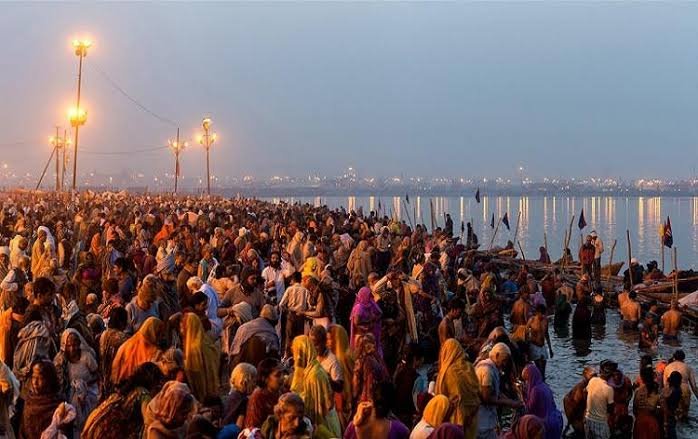Makar( a) Sankranti the fests associated with Makar Sankranti are known by colorful names Magh Bihu in Assam, Maghi in Punjab, Maghi Saaji in Himachal Pradesh, Maghi Sangrand or Uttarain( Uttarayana) in Jammu & Kashmir, Sakrat in Punjab & Haryana, Sakraat in Rajasthan, Sukarat in central regions of India, Pongal in pondicherry, Tamil Nadu & Andaman Nicobar island, Uttarayana in Uttar Pradesh & Gujarat, Dahi Chura in Bihar, Makar Sankranti in Odisha, Ghughuti in Uttarakhand, Karnataka, Maharashtra, Goa, West Bengal( also called Poush Sankranti or Mokor Sonkranti), Sankranti in Andhra Pradesh and Telangana, Maghe Sankranti( Nepal), Songkran( Thailand), Thingyan( Myanmar), Mohan Songkran( Cambodia), Til Sakraait in Mithila, Maghe Sankranti Nepal, and Shishur Senkrath( Kashmir). On Makar Sankranti, the Sun god is worshipped along with Vishnu and goddess Lakshmi throughout India.
Makar Sankranti is observed with social fests similar as various decorations, pastoral children going house to house, singing and asking for treats in some areas, melas( expositions), balls, vampire flight, backfires and feasts. The Magha Mela, according to Indologist DianaL. Eck, is mentioned in the Hindu grand Mahabharata. numerous spectators go to sacred gutters or lakes and bathe in a form of thanks to the sun. Every twelve times, the Hindus observe Makar Sankranti with Kumbha Mela – one of the world’s largest mass passage, with an estimated 60 to 100 million people attending the event. At this event, they say a prayer to the sun and bathe at the Prayagaraj convergence of the River Ganga and River Yamuna, a tradition attributed to Adi Shankaracharya.
Makar Sankranti and Uttarayana
Makar Sankranti is celebrated when the Sun’s ecliptic longitude becomes 270 ° measured from a fixed starting point which is in opposition to Spica, i.e. this is a sidereal measure. Uttarayana starts when the Sun’s ecliptic longitude becomes 270 ° estimated from the Vernal equinox, i.e. this is a tropical measure. While both concern a measure of 270 ° their starting points are different. Hence, Makar Sankranti and Uttarayana do on different days. On the Gregorian timetable, Makar Sankranti occurs on 14th/ 15 Jan; Uttarayana starts on Dec 21st.
Due to the precession of the equinoxes the tropical wheel( i.e. all the equinoxes and solstices) shifts by about 1 ° in 72 times. As a result, the December solstice( Uttarayana) is continuously but veritably sluggishly moving down from Makar Sankranti. Again, the December solstice( Uttarayana) and Makar Sankranti must have coincided at some time in the distant history. Such a coexistence last happed 1700 times back, in 291 announcement
Significance of Makar Sankrant
Every time Makar Sankranti is celebrated in the month of January. This jubilee is devoted to the Hindu religious sun god Surya. This significance of Surya is traceable to the Vedic textbooks, particularly the Gayatri Mantra, a sacred hymn of Hinduism set up in its Book named the Rigveda. According to the constitution of God, Our Holy Vedas and Shrimad Bhagwat Geeta, if we take inauguration from a Complete practitioner/ Saint and worship Supreme God and attain liberation. By performing true Book- grounded way of deification, one’s life becomes blessed, and the Earth will come heaven.
Makara Sankranti is regarded as important for spiritual practices and consequently, people take a holy dip in gutters, especially Ganga, Yamuna, Godavari, Krishna and Kaveri. The bathing is believed to affect in merit or forgiveness of once sins. They also supplicate to the sun and thank for their successes and substance. A participated artistic practices set up amongst Hindus of colorful corridor of India is making sticky, set sweets particularly from sesame( til) and a sugar base similar as jaggery( gud, gur, gul). This type of sweet is a symbolism for being together in peace and joyfulness, despite the oneness and differences between individualities. For utmost corridor of India, this period is a part of early stages of the Rabi crop and agrarian cycle, where crops have been sown and the hard work in the fields is substantially over. The time therefore signifies a period of socializing and families enjoying each other’s company, taking care of the cattle, and celebrating around backfires, in Gujarat the jubilee is celebrated by flying harpies.
Makara Sankranti is an importantpan-Indian solar jubilee, known by different names though observed on the same date, occasionally for multiple dates around the Makar Sankranti. It’s known as Pedda Panduga in Andhra Pradesh, Makara Sankranti in Karnataka, Telangana, and Maharashtra, Pongal in Tamil Nadu, Magh Bihu in Assam, Magha Mela in corridor of central and north India, as Makar Sankranti in the west, Makara Sankranti or Shankaranti in Kerala, and by other names.

